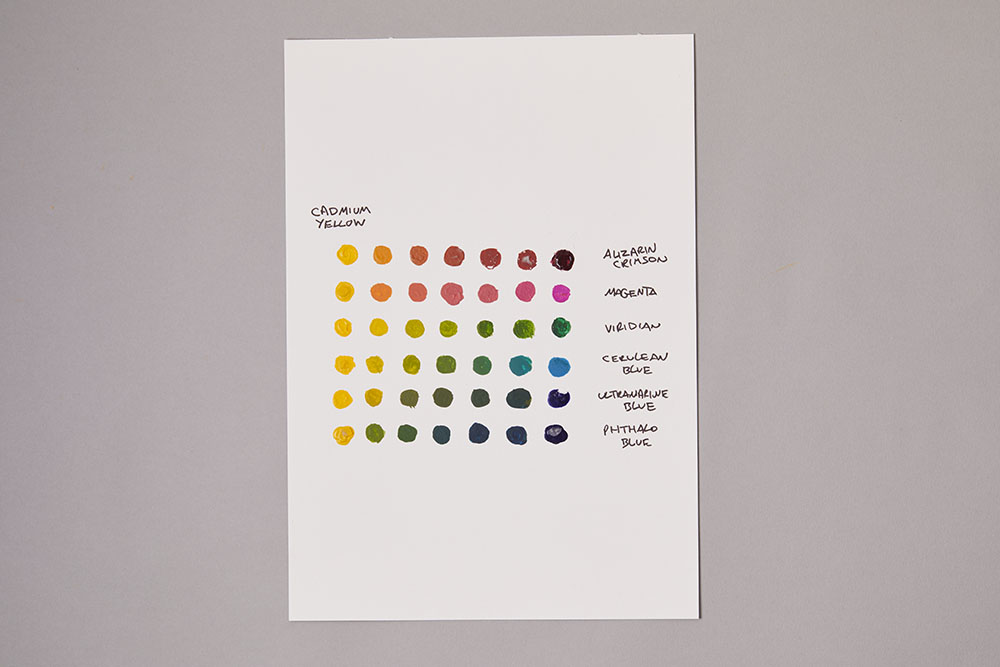In our celebration of our hero colour Cadmium Yellow we wanted to delve into the anatomy of this colour and unearth what makes it such a unique pigment. To explore this a little further we did a series of colour tests such as swatching, colour wheels and dot cards using watercolour and acrylic to showcase this pigments characteristics.
Cadmium Yellow is a single yellow pigment, is a wonderful compliment to any palette. When used directly from the tube, it is bright and brilliant and can be used to create some wonderful colourful combinations. One of the most striking characteristics of cadmium yellow is it's bright and bold yellow hue that can range from a pale, lemony tone to a deep, golden hue. This colour is highly desirable for artists who want to create a sense of warmth and light in their compositions. Cadmium yellow is often used in paintings to create highlights, as it can make a colour pop and add a sense of depth to the overall image.
Another important characteristic of cadmium yellow is its lightfastness. This means that it resists fading over time when exposed to light. This is a highly desirable trait in a pigment, as it ensures that the artwork will retain its vibrancy and intensity for years to come. It is also highly opaque, which means that it can cover underlying layers of paint effectively and create a solid color. This makes it an excellent choice for artists who want to create bold, graphic shapes or who want to add texture to their artwork.

The below colour swatches have been made using a selection of complimentary colours to show the subtle variations of tone of this pigment when mixed together. The clean watercolour in the column to the right features varied mixtures of the two colours in the middle, Cadmium yellow at the top, and the corresponding colour to be mixed at the bottom. The additional columns to the right of this one showcase what happens to each Cadmium Yellow once combined its corresponding colour what happens when it is gradually mixed with water so you can see the subtle tonal shifts.
CADMIUM YELLOW AND ULTRAMARINE BLUE

Cadmium Yellow and Ultramarine Blue can create quite earthly greens, which when mixed with small quantities of subtle brown/green tones. It’s worth remembering that the specific tone or shade of green will depend on the relative proportions of the two colours used in the mixture. If you use more cadmium yellow, the resulting green will be warmer and closer to yellow-green, while using more Ultramarine Blue will result in a cooler and bluer green.
CADMIUM YELLOW AND ALIZARIN CRIMSON

If you mix the colours in equal parts, you will get a muted orange tone. By adding more cadmium yellow, the resulting colour will be warmer and closer to yellow-orange. Adding more alizarin crimson will create a more reddish-orange tone. If you use more alizarin crimson than cadmium yellow, you can create darker reddish-brown hues.
Colour Mixing Wheels
It's always good to showcase subtle variations in the tone of a colour by using a colour base wheel and select some complimentary colours. In the centre you place your hero colour, in this case Cadmium Yellow, mixed with water. The on the outer rings preferably 2 warm and 2 cool colours. Then modify your colours the closer they get together, for example, the second ring out from your hero colour you have more a mixture of Cadmium Yellow and your outer colour then add more of the outer colour for the third ring. These allows you to do see the subtle variations of mixtures with the chosen colour.

Warm Complimentary Colour Mixtures

Acrylic Cadmium Yellow Dot Cards
Paint dot cards are also useful tools used in painting to help artists choose and match colours accurately. They typically consist of a small card or paper sample that contains dots of different paint colours arranged in a grid pattern. The dots are usually made by applying a small amount of paint to the card using a brush or other applicator. The colours are usually labelled next to or beneath each dot, allowing the artist to easily identify and select the desired colour. In these dots as we’re heroing Cadmium Yellow we mad that the focus and chose a selection of complimentary colours to show the different shades turn out but this time in a more opaque aesthetic using acrylic.
